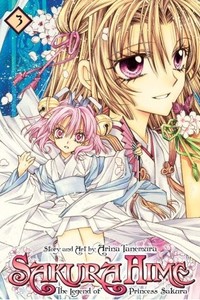Review
by Rebecca Silverman,Sakura Hime: The Legend of Princess Sakura
GN 3
| Synopsis: |  |
||
With Ouri's true nature as a youko revealed, Sakura must determine whether or not she is capable of killing her former friend. But Ouri is not the only human Enju has corrupted, and now Sakura must also protect herself and Aoba from this second youko as well – with a little help from Kohaku and Hayate, that is. Later she and Aoba come to some important realizations about their relationship and a face from the past comes forward in a surprising way. |
|||
| Review: | |||
While this series is no Kamikaze Kaitō Jeanne, Arina Tanemura's return to the magical girl story is a welcome one. The unusual setting of Heian (794-1185) Japan is one that allows for some gorgeous settings and costumes, and even though Tanemura isn't always faithful to the period, it certainly gives the series an edge. That said, the second half of this volume is much stronger than the first, so there's some mediocrity to get through before Tanemura admittedly launches the series she initially wanted to write. The first half of the book deals with wrapping up the Ouri storyline from volume two. Readers may remember that when Ouri's family home was attacked by Enju the youko she was injured and possessed. Last time Sakura declared herself unable to kill Ouri, and the creature she had become fell from a cliff. Now our heroine is forced to revisit that decision. It is one of those moments that can define a magical girl, and as always, Tanemura pulls her heroine through it admirably. The only real complaint about this section is that the author felt that she couldn't dwell on the sadness too much. That really detracts from the impact of Sakura's decision and its aftermath. Tanemura offers the excuse that she felt badly for the characters and admits she “drew it blandly.” To some readers this will seem frankly lame, as followers of the author know that she is capable of much more. The second part is, as was mentioned, much stronger. It begins with Sakura reminiscing about her deceased older brother Kai with Kohaku and the still-adorable Asagiri. She admits that she still mourns him and cannot understand how it was that he died while she is immortal. Soon the answer to that is revealed, and it is, if not a shock, emotionally done. Also revealed are the depths of the Emperor's machinations. Until now all we knew was that he had a hand in the betrothal of Aoba and Sakura, but now his true nature is unveiled. This is where Tanemura shines. The reveal is both horrifying and traumatic, providing good insight into several of the characters as well as the greatest hurdle that Sakura herself, and to a lesser degree Aoba, will have to overcome. While the eight chapters previous to this kick-off do not seem precisely to be a prologue to the greater series, they definitely have a lighter, or perhaps blander, tone. If you have been ambivalent about the series before now, give yourself this volume before deciding to drop it. Things, as you may have guessed, really pick up. Tanemura mentioned last volume in her nearly interminable author comments that she was trying scale down on the use of screentones in Sakura Hime: The Legend of Princess Sakura. A side-by-side comparison of this with, for example, Full Moon, does reveal a slight lessening of the sparklies, but only slight. Mostly tones appear in the background to denote the mood, and they can at times get a bit overwhelming. Largely, however, her art is still the same like-it-or-leave-it style that has been the defining feature of her series from day one. Eyes are huge and sharply lashed, men are severely under endowed, and hair has a beautiful flow that snakes across the page. Particularly remarkable is Sakura's transformation sequence in chapter eight. It has real movement and may call to mind the transformations in the magical girl classics, most specifically Sailor Moon. Generally Tanemura's art does give a feeling of motion, most notably in the action scenes. As has been mentioned, historical accuracy is not a selling point of this series. While clothing is era-correct, women consistently show their hands, a major no-no for the Heian period, and kissing – a western import in the Edo period – abounds. For most people this will not be a drawback, but it is worth noting for those who will be bothered. All of that aside, Tanemura does answer that very important question of what men did with their hair under those tall, keel-shaped hats. While Sakura Hime: The Legend of Princess Sakura is not Tanemura's finest work, it is still a welcome return to the classic magical girl story. The start has been a bit slow, but with the plot the author wanted rearing its head, it seems safe to say that the series will get better from here. |
| Grade: | |||
|
Overall : B-
Story : B+
Art : B
+ Attractive art, elements of classical magical girl works, building excitement. |
|||
| Production Info: | ||
|
Full encyclopedia details about Release information about |
||